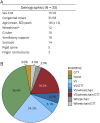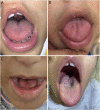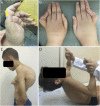Clinical Manifestation of Nebulin-Associated Nemaline Myopathy
- PMID: 36714460
- PMCID: PMC9879277
- DOI: 10.1212/NXG.0000000000200056
Clinical Manifestation of Nebulin-Associated Nemaline Myopathy
Abstract
Background and objectives: Nemaline myopathy (NM) is a genetically heterogeneous inherited myopathy related with at least 12 genes, whereas pathogenic variants in NEB gene are the most common genetic cause. The clinical spectrum of NM caused by NEB pathogenic variants (NM-NEB) is very broad, ranging from mild to severe presentations manifesting with generalized weakness, as well as respiratory and bulbar involvement. There is currently not enough data regarding the progression of the disease. In this study, we present a genotypic and phenotypic spectrum of 33 patients with NM caused by NEB variants (NM-NEB) classified according to age groups and the use of ventilatory support. We focused on interventional support, genotype-phenotype correlation, and association between respiratory, bulbar, and motor systems in groups of patients stratified by age and by the use of ventilatory support (VS).
Methods: Clinical and genetic data from patients with NM-NEB followed up in one specialized center were collected through regular consultations. Patients were evaluated regarding motor, bulbar, and respiratory functions.
Results: Thirty-three patients with NM-NEB were evaluated consisting of 15 females and 18 males with an average age of 18 (±12) years and a median of 17 (±11) years. 32% of patients with NM-NEB used a G tube, 35% were not able to walk without support, and 55% needed VS. Scoliosis and dysphagia were more common among patients who used VS. Described for the first time, half of the patients presented tongue atrophy in a triple furrow pattern, and the presence of the atrophy was associated with dysphagia. Comparing the patients grouped by age, we found that, proportionally, older patients had more scoliosis and respiratory dysfunction than younger groups, suggesting the progression of the disease in these domains. In addition to that, we showed that VS use was associated with scoliosis and dysphagia.
Discussion: NM-NEB is a very debilitating disease. There is an association between scoliosis and respiratory dysfunction while patients using VS have more often scoliosis than the no-VS group. Triple furrow tongue atrophy is a novel and frequent finding, which is directly associated with dysphagia. Grouping patients by age suggested disease stability in motor and swallow function, but a progression in respiratory dysfunction and skeletal deformities. All observations are relevant in the management care of patients with NM.
Copyright © 2023 The Author(s). Published by Wolters Kluwer Health, Inc. on behalf of the American Academy of Neurology.
Figures






References
LinkOut - more resources
Full Text Sources
